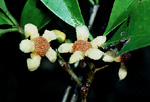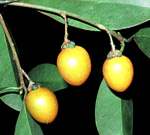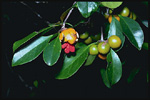 |
This small, essentially tropical family is especially diverse in south-east Asia and China, where its best-known genus is Camellia. Only one genus (Ternstroemia) is native to Australia, occurring hn rainforests on Cape York Peninsula.
Characteristic features of the family Theaceae in Australia include: - small trees with large, shiny, entire leaves that are alternate or in false whorls
- flowers small, axillary or growing on the branchlets, with 5 free sepals and petals and many stamens
- ovary superior, developing into an orange, globular fruit which splits irregularly to reveal the bright red seeds
Description
Evergreen trees or shrubs. Internal secretions not obvious. Plants glabrous, or with simple, non-glandular, unicellular hairs. Leaves alternate and spiral, or in whorls of 3–5, petiolate or subsessile. Stipules absent. Lamina simple, symmetric, lanceolate, ovate, elliptic, oblanceolate, obovate or oblong; base cuneate or attenuate; margins entire, ±flat; venation pinnate, with the midrib conspicuous, and the tertiary venation not reticulate; surfaces not punctate; leathery. Male and female flowers occurring on the same plant or on separate plants, or with all the flowers bisexual. Inflorescences axillary or intercalary, consisting of racemes or solitary flowers. Bracts absent. Bracteoles present. Pollination by insects. Flowers fragrant; stalked. Floral disc present or absent; nectaries present on the carpels or the stamens. Perianth regular, of 2 dissimilar whorls, imbricate in bud. Calyx segments free, of 5 sepals, herbaceous or succulent. Corolla segments free or fused, with 5 petals or 5 lobes, alternating with the sepals; corolla wheel-shaped or bell-shaped, white, cream or yellow, without contrasting markings, membranous or succulent; claws absent; lobes ±entire. Fertile stamens numerous, not clearly correlated with the sepals, free or at least partly fused to the corolla, free of the ovary and style, distinct from each other, all ±equal. Anthers basifixed, not versatile, opening inwards by longitudinal slits, 2-celled. Ovary superior and sessile. Carpels 1–5, fused; ovary with 2 locules. Style terminal, single and unbranched, or single and branched above. Ovules 1–2 per locule, stalked; placentation apical or axile. Fruit dry or fleshy, dehiscent or indehiscent; a capsule with irregular or loculicidal dehiscence, or a berry; the perianth on the maturing fruit deciduous or dry and persistent. Disseminule micro-surface ±smooth, yellow, orange, red, pink, magenta, purple or violet or brown, glossy or dull. Seeds 1–2 per fruit. Aril absent. Cotyledons 2. Embryo straight, curved or sharply bent.
(Note: this description has been generated from the coded data compiled for the key. Any errors in the key data will be reflected in the descriptions.)
A treatment of the family Theaceae has not yet been published in the Flora of Australia. It will appear in Volume 6.
Australian genera of Theaceae (as recognised for the Flora of Australia)
* = all species introduced
*Camellia
Ternstroemia

|
  |

Camellia sinensis (flower)
Photo: anon © NSW National Herbarium

Ternstroemia cherryi (flowers)
Photo: G.Sankowski © Zodiac Publications

Ternstroemia cherryi (fruits)
Photo: G.Sankowski © Zodiac Publications

Ternstroemia cherryi (fruits)
Photo: H.Nicholson © H. & N. Nicholson
|
 |
|